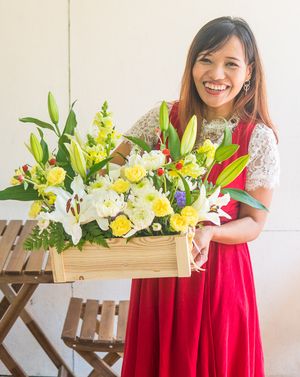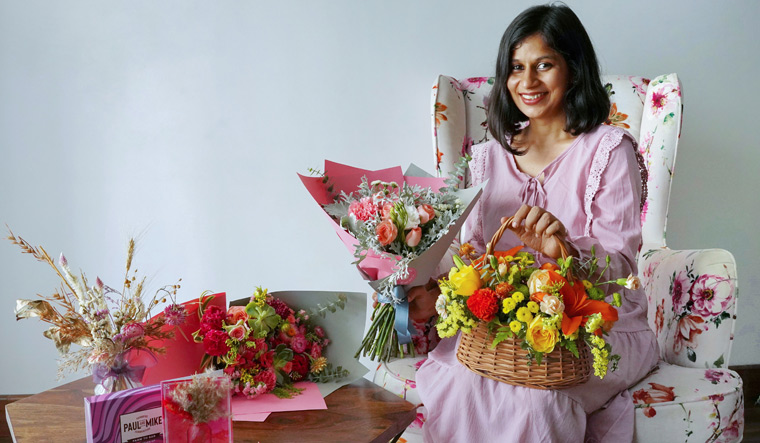A weekly emailer from a favourite publication should be a box of roses—enchanting, unexpected and uplifting. We subscribe to it for comfort browsing in idle hours. What if the same service is transferred to weekly doorstep deliveries of real flowers handpicked by experts in the trade?
Mumbai-based Christine Langstieh is the crazy flower-lady who was once a corporate jet-setter, a lawyer-turned-compliance consultant for 10 years before she abandoned it all to set up a weekly flower subscription service called Bloombombs in 2019. Ask Langstieh and she will tell you how floristry is serious business. She trained at the London Flower School, where she learned the mechanics of flower arrangement.
Back in India, while she is not exactly building intricate, jaw-dropping flower walls, arches and chandeliers for events, she works with cut flowers and make blooms last longer in that corner vase. She says the Indian flower industry is under-represented in its own country. “In India, from a consumer perspective, a lot of the flowers are geared towards events—weddings, engagements and brand promotions,” says Langstieh, who grew up in Shillong amid a verdant garden culture. “These flowers last only for a couple of hours. After coming back from London, I started visiting flower farms from Maharashtra to Nagaland to understand how I could get better quality flowers for my weekly deliveries.” She adds that though India is one of the biggest exporters of flowers, we do not see even 1 per cent of those quality flowers. “Because people do not want to pay for such flowers,” says Langstieh. “And that is because we have had flowers from our local florists which last a day or two. Part of the challenge was convincing the farmers to start supplying to me, so I could build a customer base willing to pay more for premium flowers that last longer.” Her weekly box of posies curated according to seasons, colours and textures—starting with a monthly plan of Rs600—often include big, bold, bodacious sunflowers and chrysanthemums that look like spiders and buttons. Rare, lesser-known stunners on offer include lisianthus, snapdragon, canna lily, celosia or the rose-like Renee Ranunculus, also called the Persian Buttercup. “Growing flowers is not a cheap business,” says Langstieh. “These farms have gone to write their initial investment at Rs50 lakh because they grow these flowers in massive greenhouses and not on fields.” Her business was hit during the pandemic with shuttered farms and curtailed transportation. But now it is beginning to bloom again.
If 2020 saw a home gardening boom with plants as the dominant foliage for hemmed-in apartment dwellers, this year sweet, fresh flowers are bursting on tables and desks. Until the second Covid-19 wave struck, a slew of flower subscription services was picking up speed in Indian metros with home deliveries of freshly cut flowers in blazing colours, with instructions on how to keep them radiant for up to a week. With the gradual lifting of lockdown curbs, old customers are now coming back.
“We have grown post the Covid scenario, because more people are working from home,” says Swati Bhalla, who started the flower subscription firm Bunchary in New Delhi three years ago. “Previously, we delivered to offices as well, now office deliveries are almost zero. In the last year, we have grown by at least 30 to 33 per cent.” Bhalla started her firm after quitting a career of 15 years in visual merchandising. Depending on the number of sticks, her subscription plans called Gul, Gulshan and Gulfam range from Rs1,500 to Rs2,500 per month. It typically includes carnations, gerberas, rajanigandhas (tuberoses), gladiolus, dahlias, chrysanthemums, with nargis (narcissus poetics) being most popular along with some Asiatic and oriental lilies thrown in.
“If you order orchids, you will easily find the purple and blue ones in the market,” says Bhalla, who sources most of her produce from the Ghazipur flower market. “But we look for spider orchids and in colours not easily available. Again, pink lilies are easily available, but we go for peach and yellow. Something as uncommon as alstroemeria (or Peruvian lily) is also part of our offerings. Larkspurs are sought after, but they are not pet-friendly.”
Amit Tripathi, who started Bring My Flowers in 2016, built up a database of 4,500 customers for his weekly deliveries of tuberoses, lilies and orchids last year—with 1,500 customers in Noida alone. “There are very few online flower services that allow returns. We replace the drooping bunch with a fresh batch,” says Tripathi, who quit his decade-long corporate gig with Aircel to start a flower company with his partner, Pooja.
Bengaluru-based Nidhi Gupta, a former national level gymnast, once dreamt of representing India at the Olympics. Having grown up around gardens in her family home in Alwar, Gupta preserved her fondness for flowers even when she moved cities. Her partner would always woo her with the choicest buds. But both of them fell in love with flowers irrevocably after they visited farms in France and the Netherlands. What started as an email subscription for 10-odd neighbors in her apartment complex has grown into a full-blown company called Shades of Spring, with weekly delivery services in Bengaluru, Mumbai, Chennai and Hyderabad.
While sunflowers are their biggest hit “because both men and women like it”, there are other spectacular varieties like agapanthus (or the lily of the Nile) and pineapple flowers which look like, well, a mini pineapple, and can cost around Rs150 a stem. “I was not aware that flowers can stay fresh for seven or 14 days. Now we start getting queries from our customers when flowers start drooping in four days. It is like a two-way process between us,” says Gupta who, like Langstieh, Bhalla, Tripathi and many more, has inadvertently become a flower educator as well.




